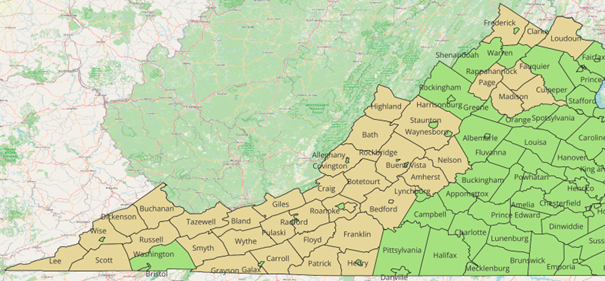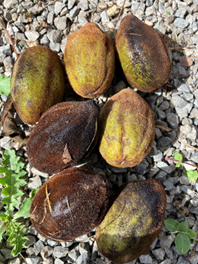- Visit
- Things to Do
- Learn
- Arboretum
- Research
- Support
- About
- People
Back on the Butternut Trail
By T'ai Roulston, Arboretum Curator & Research Associate Professor
The arboretum's search for butternut trees in Virginia took a southern turn this summer. Butternuts (also called white walnut) are declining rapidly due in large part to butternut canker disease, an introduced fungal pathogen that causes black fissures to erupt over the tree's trunk, eventually killing it. Here at the arboretum, we are trying to document the health of existing trees over diverse areas in Virginia and propagate ones from a geographically wide range. My trip this summer with newest Blandy graduate student Mia Murray spanned 4 days and a thousand miles, brushed the borders of North Carolina and Tennessee, and led us to many a riverbank where forlorn butternuts stretched horizontal over the water. That kind of tree yoga is great for reaching sunlight at the edge of a forest, but it also leads to dropping nuts to the fish below rather than to soil and squirrels for planting, and we took turns wading barefoot over the rocks for leaf and seed samples. Butternut trees need lots of light and are usually found on riverbanks, ridgetops, young forests, and roadsides, the same places you'd see black walnut trees. Riverbanks have been the best place for us to find them. For this trip, we relied on tips from professionals who are familiar with the flora of southern Virginia, dumb luck while driving down the road, and iNaturalist, an app where anyone can post pictures of plants and animals they've seen. iNaturalist was great for some of our roadside finds, but also led us to No Tresspassing signs in other places and we moved on, less productive than we'd hoped to be. For the next trip, we hope to have more help from landowners who alert us to their trees, or to anyone who notices butternuts on public land and tells us where they are. That has been the best way for us the past two years in central and northwestern Virginia.
 Our collecting scope next year is from the Appalachian Mountains in Virginia west to the border, in any area where we haven't already made a lot of collections. The brown colored counties on the map below are our targets, and they include some of the closest counties to Blandy. So if you know of locations in any of those counties, please let me know. If you see the nuts, please take a picture and email me tai.roulston@virginia.edu to confirm identification. It is challenging to identify the tree from photos without nuts. Our grand hope is to find some butternuts resistant to the blight somewhere out there, and maybe you can point us to one.
Our collecting scope next year is from the Appalachian Mountains in Virginia west to the border, in any area where we haven't already made a lot of collections. The brown colored counties on the map below are our targets, and they include some of the closest counties to Blandy. So if you know of locations in any of those counties, please let me know. If you see the nuts, please take a picture and email me tai.roulston@virginia.edu to confirm identification. It is challenging to identify the tree from photos without nuts. Our grand hope is to find some butternuts resistant to the blight somewhere out there, and maybe you can point us to one.
